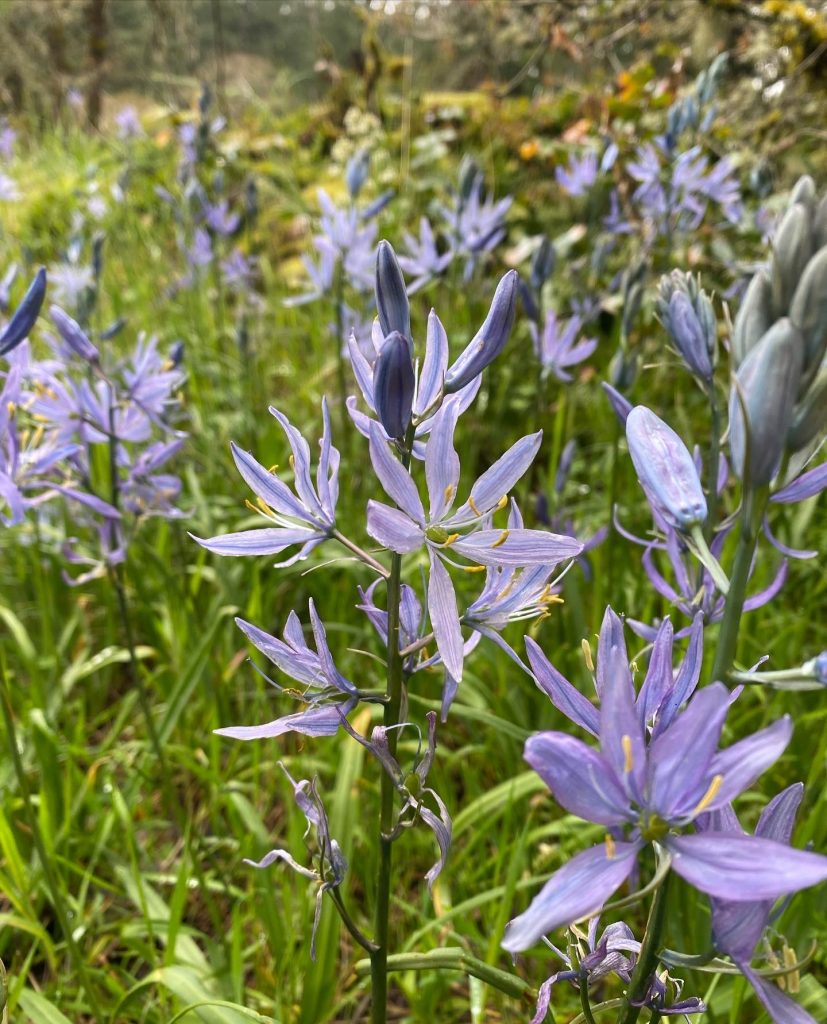
This evening I’m proud and honored to bring you a guest profile from my non-binary offspring Morgan Nelson;
On May 3rd 2020, in an act of mischievous rebellion, I sprinted through a field claimed by the Port of Camas with one intention: to pluck a few Camas Lilies from the earth (sans bulbs). Although the stakes were low, it was exhilarating. As I ran back to my vehicle upon swiping some of the blooms, I swore I could hear my grandmother laughing encouragingly at my act of opposition in the field that we would look over at every time I would come to visit her.
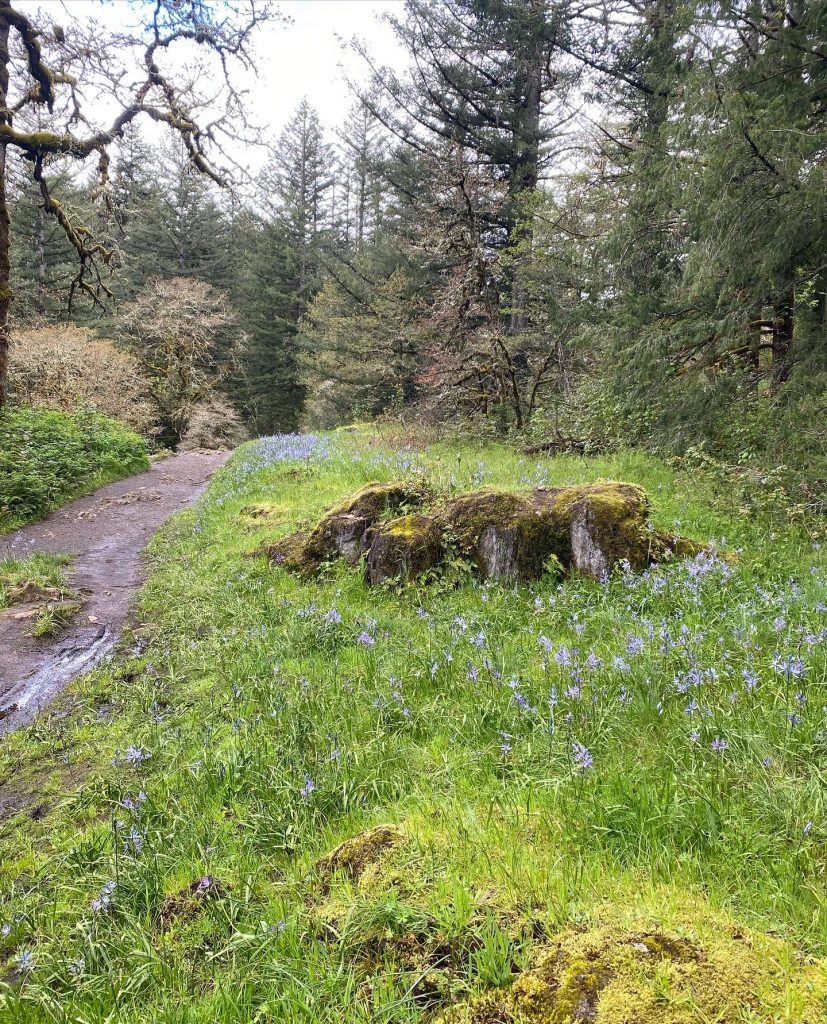
In an attempt to recreate that precious memory for the benefit of my son, I drove the various winding back roads that advise 20mph (and mean it). As we approached the field, I was crestfallen to see it had been recently mowed, and what is usually a striking collage of purple clusters within a sea of green grass was barren. Not to be discouraged, we headed for the Lacamas Falls trailhead, although he, unlike I, was not so desperate to see the Camas Lilies, and did not agree to continue on blistered feet (a discomfort due to his regrettable choice in footwear.)
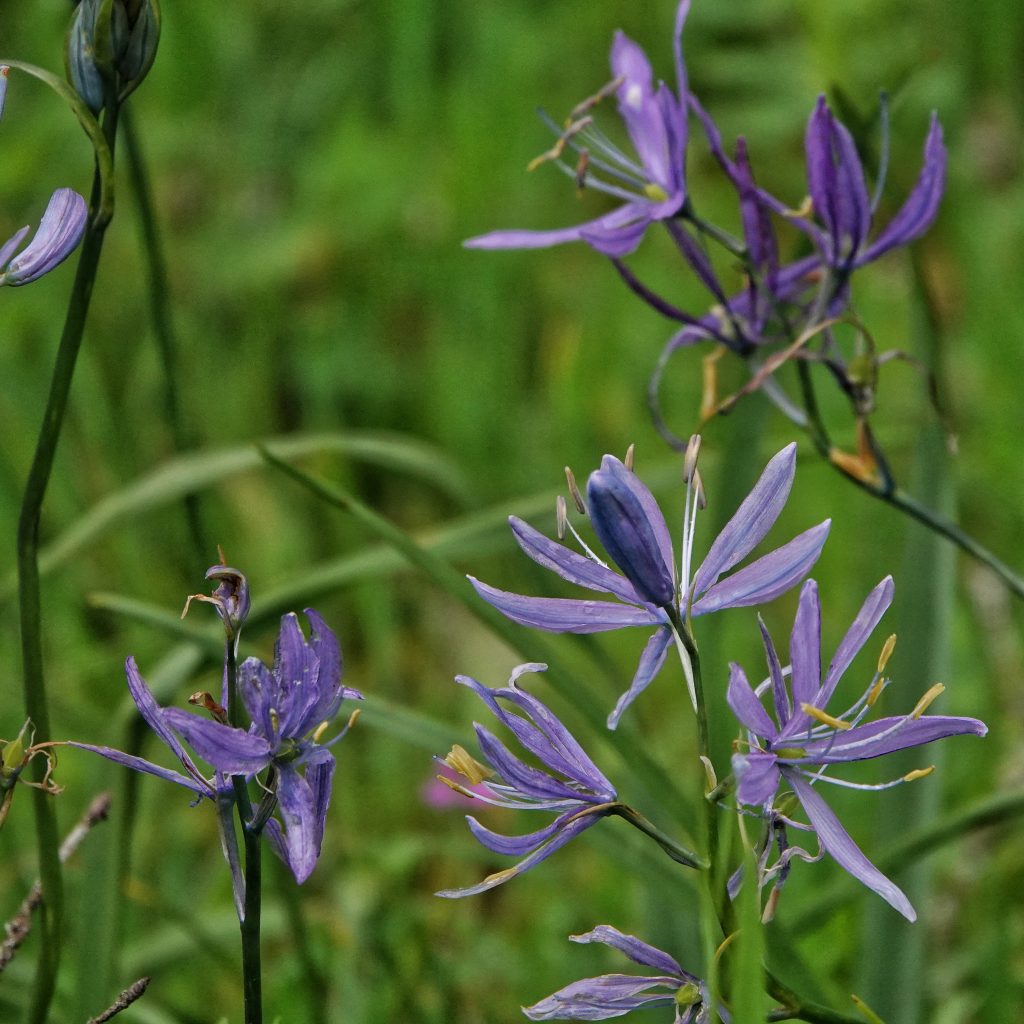
Luckily for me, my father—as any reader of this blog will know—is a self-described recreational naturalist and always up for an adventure. As is often the case, we wander through a natural area while I blather on about life. My father patiently and carefully navigates my stories and the wilderness, working effortlessly not to hit me in the face with random twigs. Camas Lilies are visually striking and despite having seen them every year since 6th grade, I will never tire of them. As with so many flora and fauna, we are blessed in the Pacific Northwest to have relatively unfettered access to these unique, indigenous flowers.
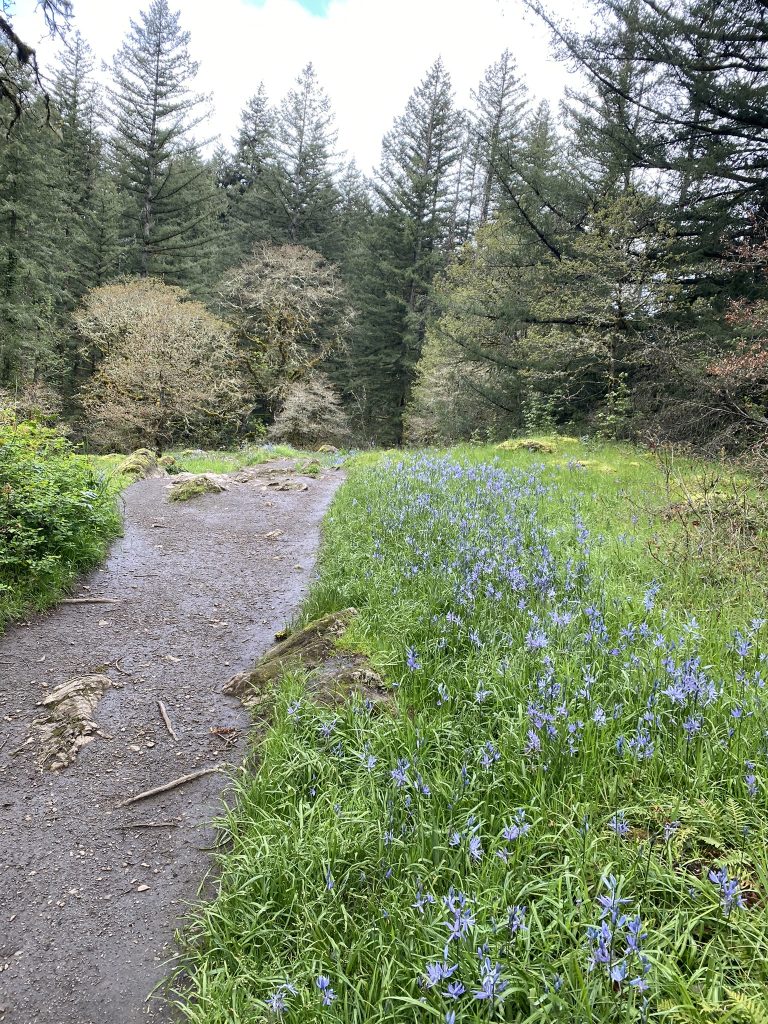
On May 3rd 2022, as we were approaching the fields, my father said something he simply can’t help but to say: “Hey Morg, watch out! There’s poison oak all around here.” In these moments, despite my usual response of “I know Dad” I am always grateful that my father looks out for me. As we stood regarding the glorious fields I was overcome with appreciation for these flowers, for this preserved natural area, and for my father for instilling in me from birth a sense of respect and wonder toward the land and the creatures that inhabit it, even if my expression of that respect and wonder often looks like calling flowers and small creatures “cute,” only half listening as he details the technical information of different organisms.
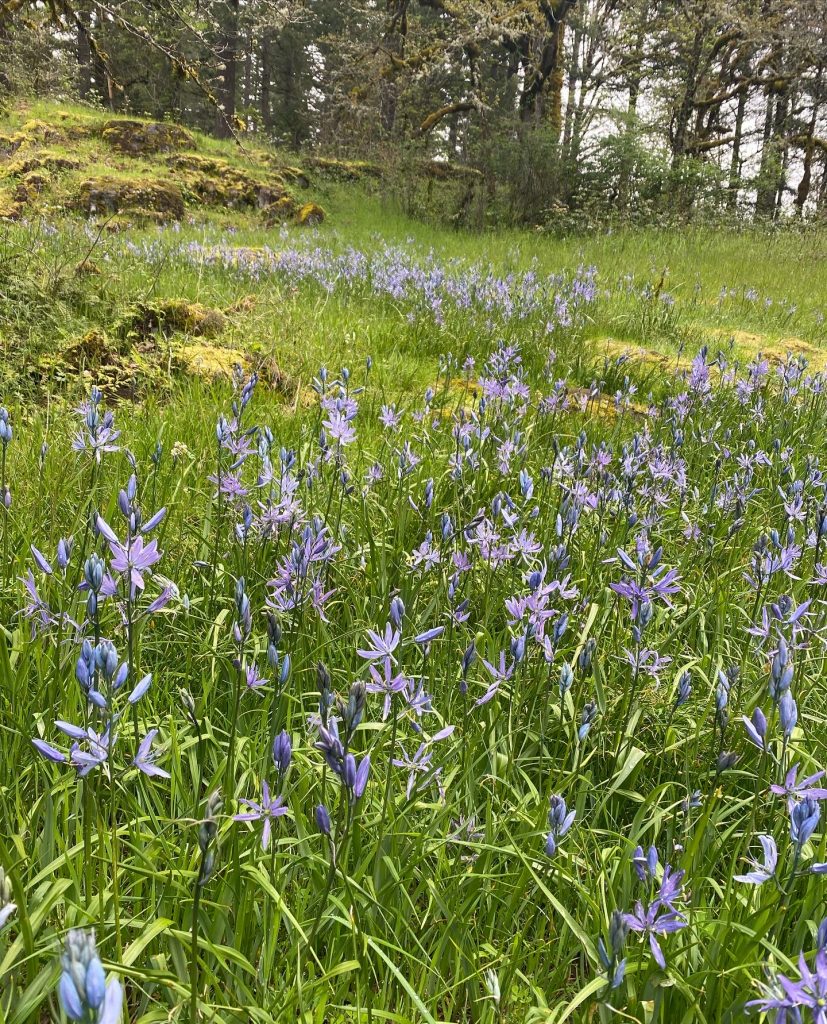
Despite this, my father’s pursuit of knowledge, of knowing and understanding each species, is admirable to me. He is not comfortable only having a vague idea about the natural world around him and although I am glad to see him engaging in various hobbies in his retirement, his work cataloguing the unique features of so many interesting species deserves to be continued.
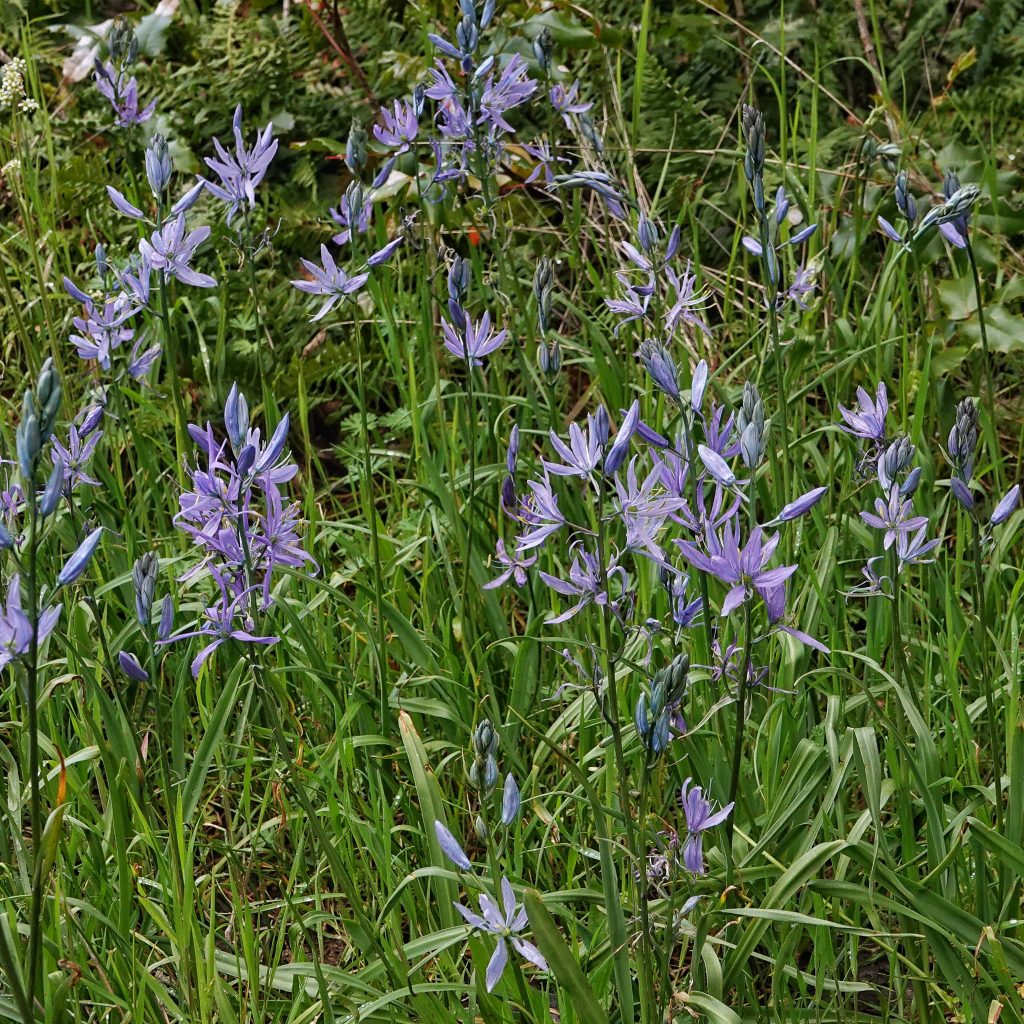
I often make sense of the world by learning as much as I can about human behavior, systems of inequity and oppression, and working to preserve family dynamics in order to heal generational trauma, and I requested to pen this guest post on Camas Lilies due in large part to their significance to the indigenous peoples of the Pacific Northwest. It is my closely held belief that conservation of our natural world cannot exist without understanding, respect, and focus on the intersection of social justice and restoration. As I reflect on the state of our climate and the ever-evolving demise of our natural resources it is not without hope. There are in fact multiple restoration projects for our beautiful Camas Lilies. I’ve included a couple of these projects below. It should be noted that the collaboration with Indigenous Peoples is vital to combating climate change.
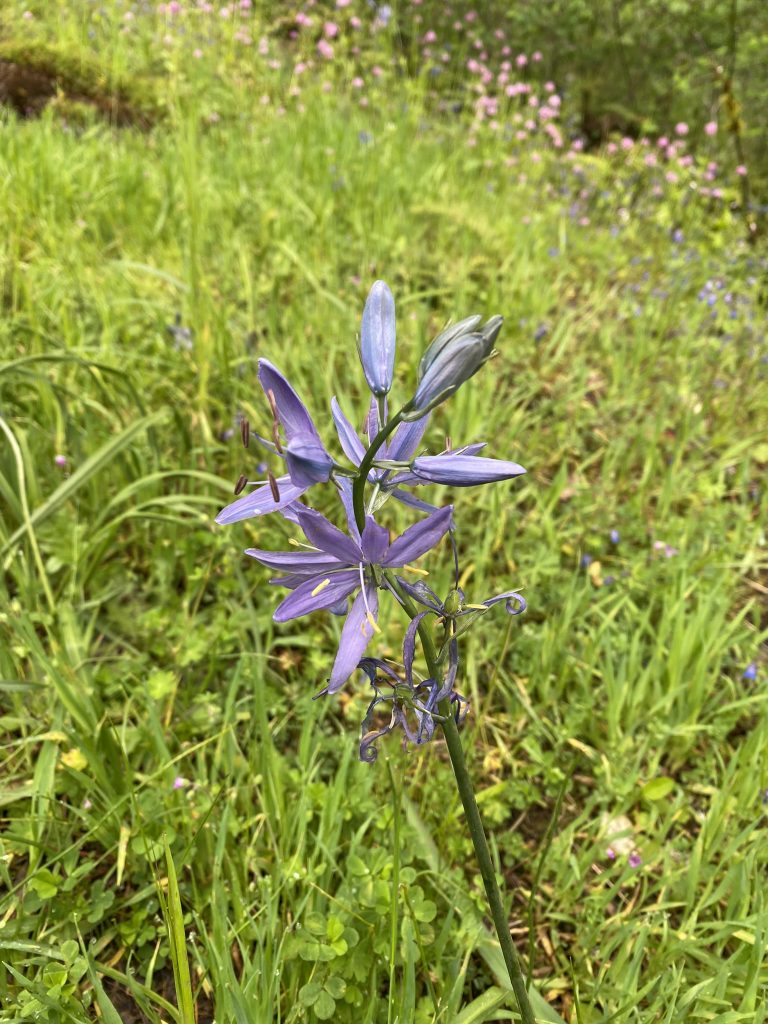
According to the site for Camas Lily Restoration done by the UW Program on the Environment and The Center for Natural Lands Management;
Common Camas was one of the most important cultural foods in the Coast Salish territory and it continues to play a key ecological role, providing early season nectar for two federal endangered butterflies and countless other pollinators. Over the past 200 years these ecosystems and the cultural practices that maintained them have been severely disrupted, due to initial Euro American colonization and the resulting proliferation of invasive species, agriculture, and urban development. There is an opportunity to revitalize cultural practices by educating younger generations and engaging both tribal and non-tribal members in conservation and restoration of these critical habitats. (https://www.confluenceproject.org/library-post/profound-role-of-camas-in-the-northwest-landscape/)
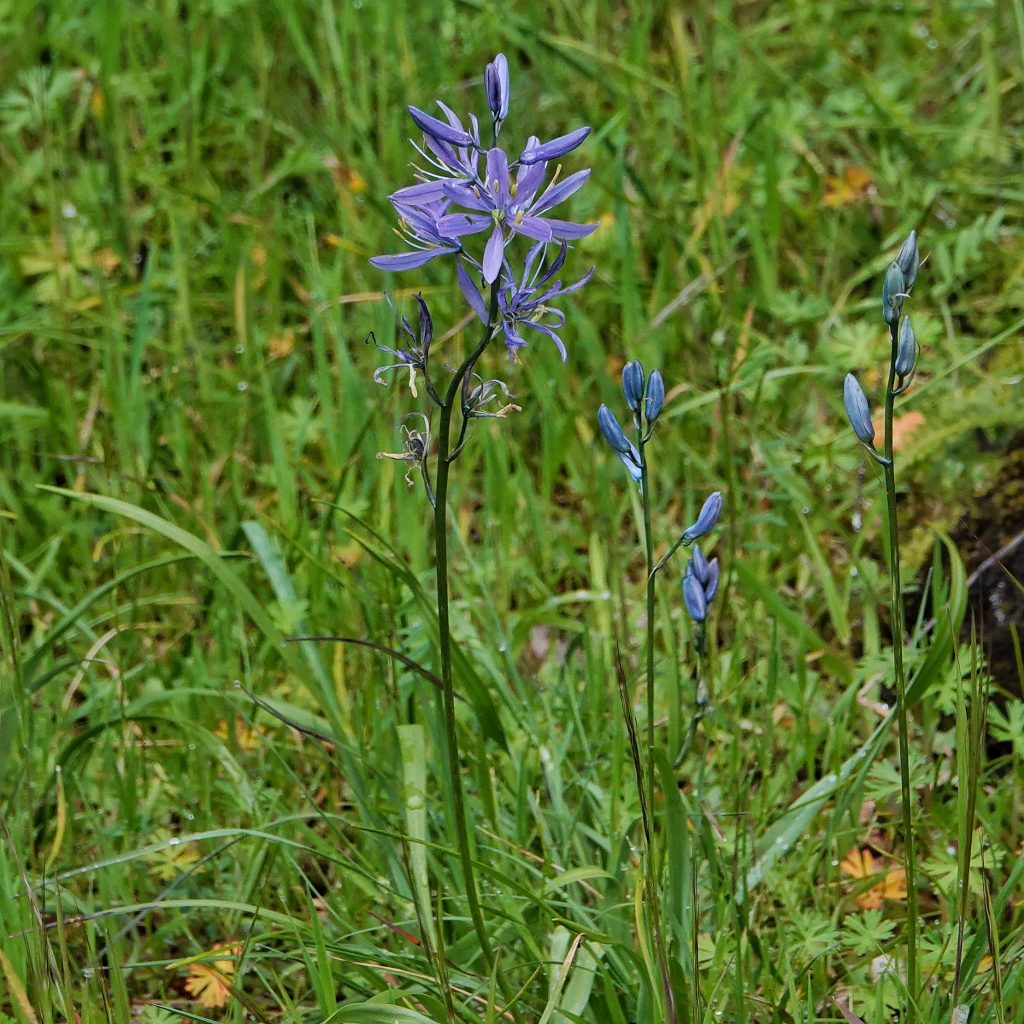
Additionally, via the US Forest Service site for the Camas Prairie Restoration Project:
When European settlers arrived in Oregon around 1850, wetland prairies covered one third of the Willamette Valley, an estimated 400,000 acres. Less than one percent, about 1000 acres of historical wetland prairie exists today because of extensive ranching and agriculture.
The Camas Prairie Restoration Project began with the re-introduction of fire. Traditionally, camas prairies were burned frequently at low intensity in late summer when the meadows were dry and the seeds released into the soil, eliminating competing vegetation, and encouraging the spread of camas. Tribal fire crews cut down encroaching ash trees and later burned the site in the fall of 1998. The following summer, Alice Smith headed up the collection of tens of thousands of camas seeds with the help of Lane Community College students, tribal members, and volunteers in order to reseed after prescribed fires. Some of the seed was planted at a private nursery to be grown out and replanted at Camas Prairie.
Camas Prairie has been burned every two years and seeds have been collected yearly for the past decade with remarkable success. Since the restoration project began, Camas plants have almost tripled in number and invasive plants have decreased by half. Other native species have been reintroduced to the site such as native tufted hairgrass, meadow barley, western red cedar trees, and hazelnut. Restoration efforts continue with the help of the Siletz Indian Nation, Grand Ronde Indian Nation, BLM, Oregon State University, Lane Community College, Youth Conservation Corps, Linn County Sheriffs’ Correction Crews and the Sweet Home Ranger District. (https://www.fs.fed.us/wildflowers/Rare_Plants/conservation/success/camas_prairie_restoration.shtml)
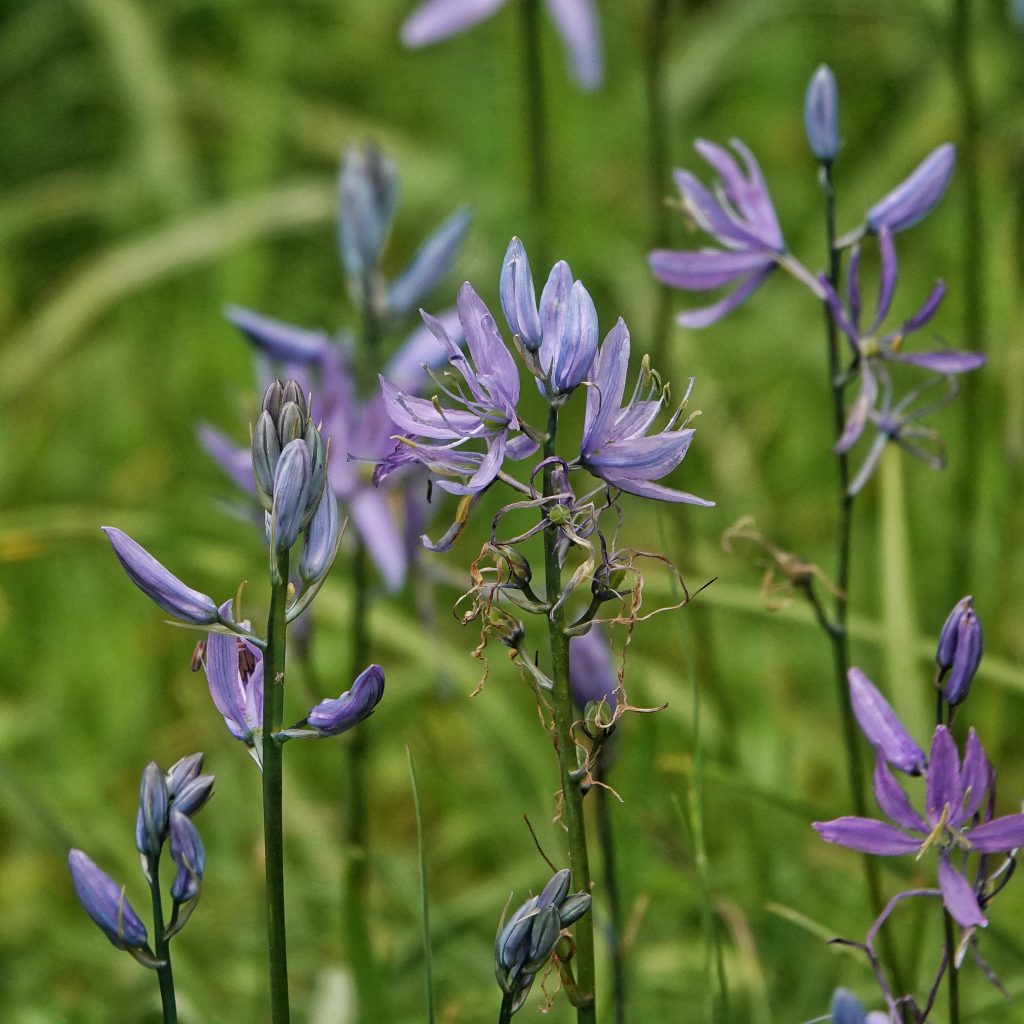
From the Washington Native Plant Society website;
Technical Description:
Camassia quamash includes a confusing array of morphologically and geographically diverse subspecies. Differentiating them remains challenging, yet genetic data have revealed a detectable molecular signature between groups that grow “east” (breviflora, quamash, utahensis) and “west” of the Cascades (intermedia, maxima, walpolei). Taxa within these groups are still unresolved (Fishbein et al. 2010).
Plant Type: Herb.
Distribution: This plant grows from southern British Columbia to northern California, and east to Montana, Wyoming, Nevada and Utah. This plant grows on both sides of the Cascades crest, and at the coast in Washington.
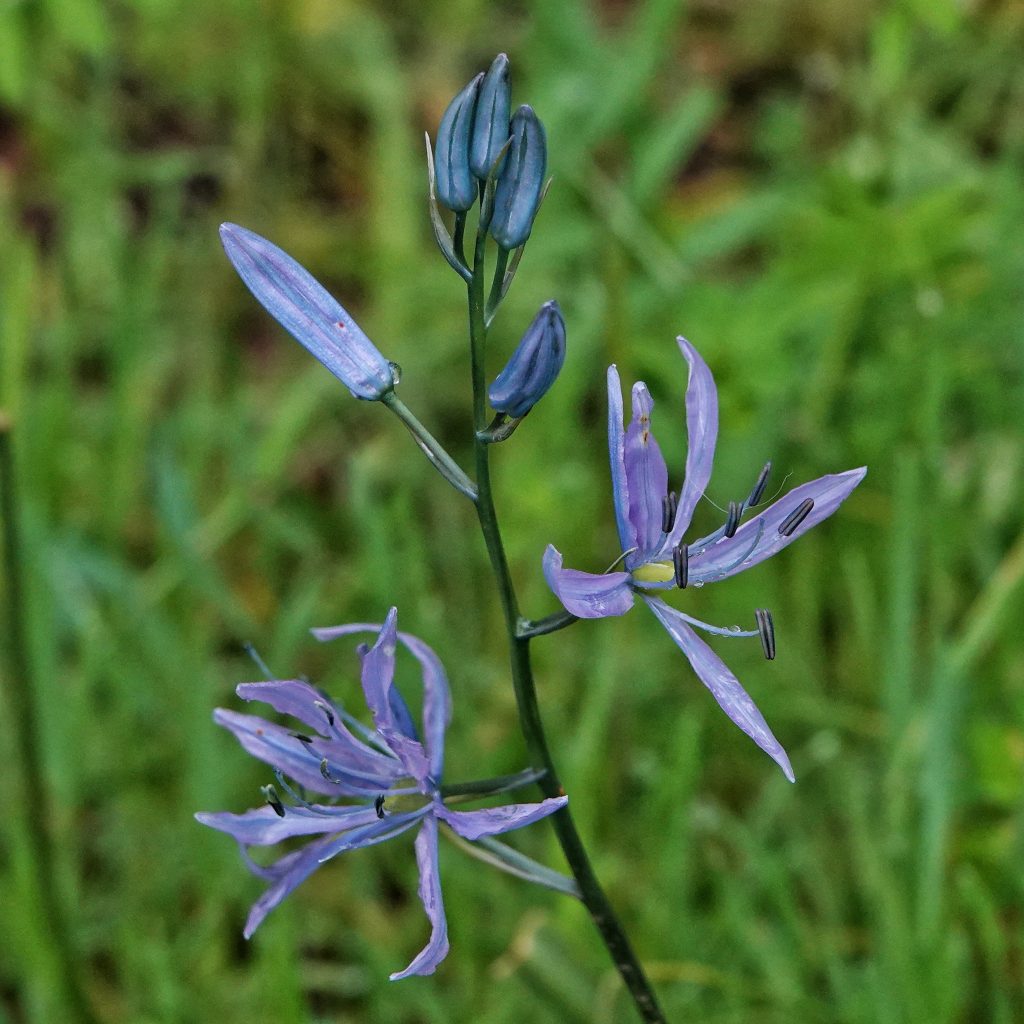
From the Washington Native Plant Society website:
Height: This plant grows 8 to 28 inches (20 to 70 cm) in height.
Flowers: A raceme containing pale to deep blue or violet flowers is produced which is 2 to 12 inches (5 to 30 cm) in length. The pedicels are approximately 1/2 of an inch to 5/8 of an inch (1 to 2 cm) in length and spread, arch, or ascend when flowering, and curved inward and upright when fruit is formed. The flower contains 6 stamens, 3 stigmas, and 6 tepals (sepals and petals which cannot be properly distinguished) which wither separately and expose the ovary. The tepals are 5/8 of an inch to 1-3/8 inches (1.5 to 3.5 cm) in length and less than 3/8 of an inch (2 to 8 mm) in width. The lowest of the 6 tepals curves outward and downward away from the others.
Leaves: Several basal leaves grow approximately 1/4 of an inch to 3/4 of an inch (8 to 20 mm) in width. The leaves are smooth, linear-lance-shaped, and grass-like with sheathing at the base, and the margins are entire (not toothed). There are no leaves on the stem.
Fruits: Capsules with 3 cells, egg-shaped to oblong, and cross-ridged grow 3/8 of an inch to 1 inch (10 to 25 mm) in length. Several to numerous seeds are produced which are shiny black and less than 1/4 of an inch (2 to 4 mm) in length.
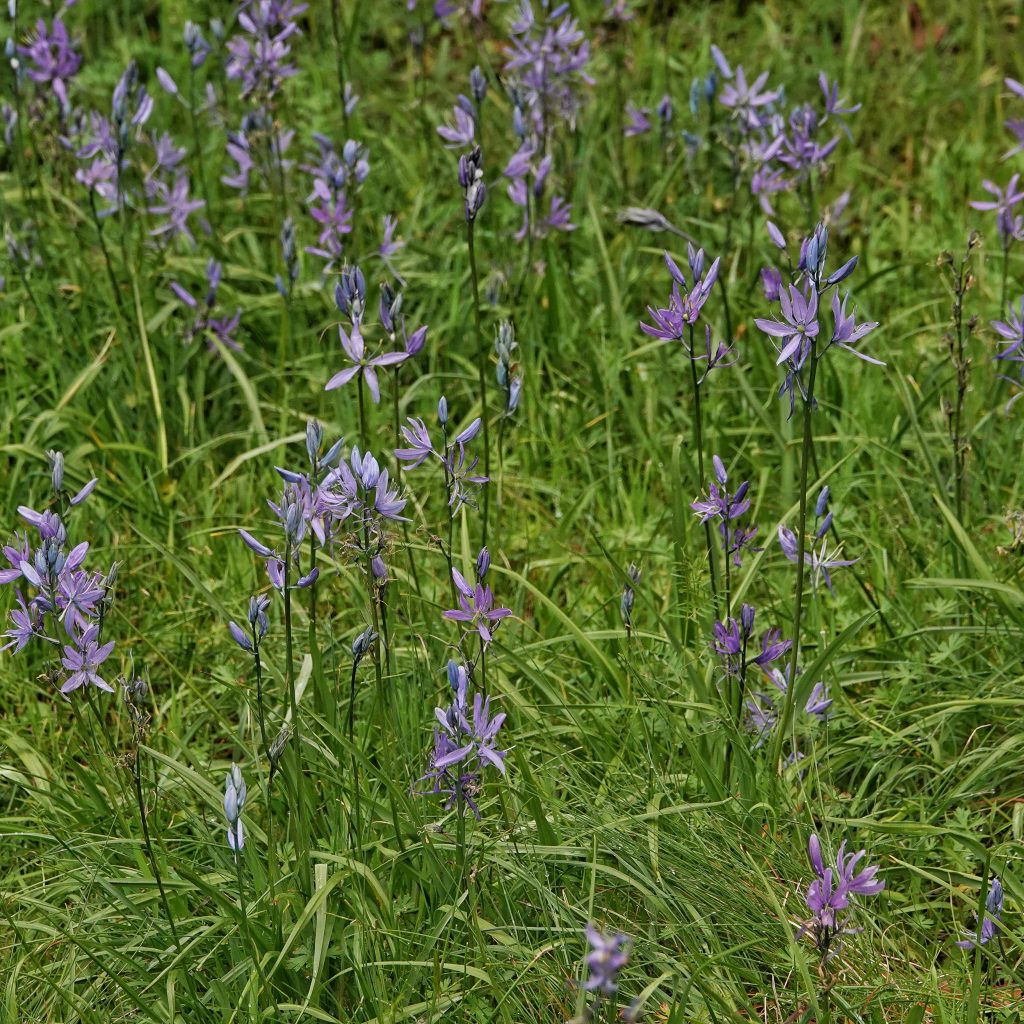
From the Washington Native Plant Society website
Notable features: The stalks containing fruit are shorter than the bracts, ascending to upright, and curved back towards the stem. This species is similar to Great camas (Camassia leichtlinii ssp. suksdorfii). The two species are distinguishable mainly by the flower characteristics where the tepals of this species do not twist together to cover and protect the fruit, while those of Great camas do. Additionally, the 6 tepals on the Great camas flower are all curved upward. Warning: Meadow Death Camas (Toxicoscordion venenosum) often grows in the same habitat as the edible blue camas species. Although Meadow Death Camas flowers are cream-colored, the bulbs are very similar to the bulbs of this species, however they are highly toxic and potentially fatal if eaten.
Subtaxa: There are four subspecies of Camassia quamash which are native to Washington.
Camassia quamash ssp. azurea has pedicels which spread when the fruit is produced, curved upward, not appressed, and the caps are held at approximately 45° from the rachis. The tepals are pale bluish-violet. This subspecies is found in glacial outwash soils, prairie mounds, and meadowlands in the Puget Trough from Pierce County to Grays Harbor County on both sides of the Olympic peninsula.
Camassia quamash ssp. breviflora has tepals which are bilateral to nearly radially symmetric and 5/8 of an inch to 1 inch (1.5 to 2.5 cm) in length and less than 1/4 of an inch (3 to 5 mm) in width. This subspecies is generally less than 20 inches (50 cm) in height and the leaves are less than 3/8 of an inch to approximately 3/4 of an inch (0.7 to 2 cm) in width. The anthers are generally yellow. This subspecies is found in south-central and southeastern Washington, to east and south Oregon, northeastern California, and eastern Nevada.
Camassia quamash ssp. maxima has leaves which are glaucous adaxially and the tepals are light blue to deep blue-violet in color. The pedicels are occasionally appressed, but often spreading, especially in the northern areas of the range. This subspecies grows from southwestern British Columbia to the southeastern end of the Willamette Valley in Oregon.
Camassia quamash ssp. quamash has tepals which wither separately after anthesis and do not fully cover the ovary. The flowers are generally distinctly bilateral. The anthers are tan to blue or blue-violet. This subspecies is common east of the Cascades crest, and grows from southern British Columbia to eastern Oregon, and east to northern Idaho and Montana.
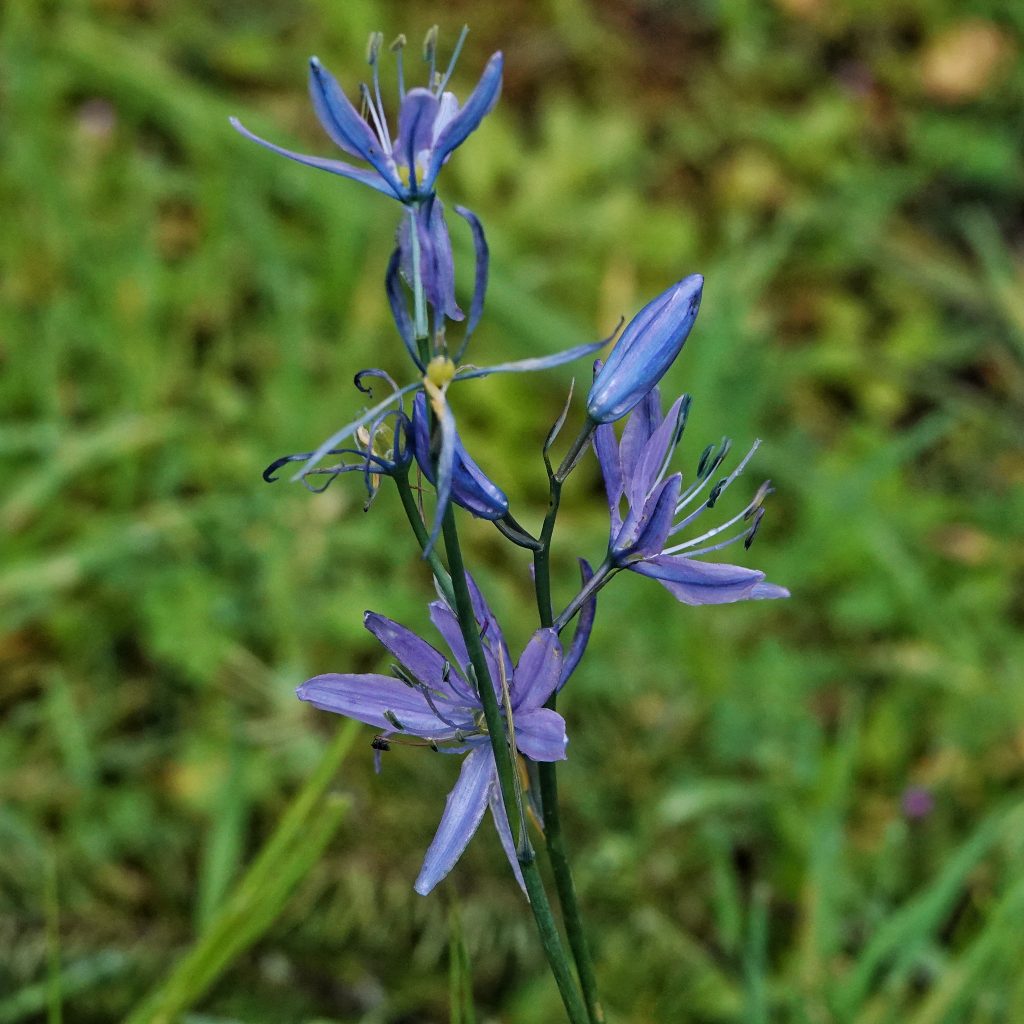
From the Washington native Plant Society website:
Restoration and Conservation:
Elk, deer and moose graze the leaves in early spring. Gophers eat the camas bulbs and aid in the plant’s reproduction by breaking up and dividing the bulbs, and also caching them in other areas allowing them to reestablish in a new place. Great camas is an important flower for pollinating insects in prairie habitats.
Ethnobotany:
Many Pacific Northwest tribes (including the Chehalis, Clallam, Hesquiat, Nlaka’pamux, and others) have used the bulbs as a food source (smashed, boiled, roasted, steamed, baked, dried). The camas root is one of the most important foods to western North American native people. Camas root was often traded and people would travel great distances to find and harvest it. Camas root is considered to be semi-agricultural by some. Families could own patches of land where only they could harvest the root. People would prepare the areas where it grew by weeding, clearing, and in some cases burning the area. The roots were harvested at certain times of the year, mostly during the summer after the camas had flowered, but some harvested it in the spring. The harvesting technique of camas also helped its growth, by overturning the soil to find the roots the soil was kept loose allowing for easier growth. Camas roots did not keep fresh very long and were sun dried to preserve them. The dried roots were rehydrated overnight and also used in cooking as a sweetener.
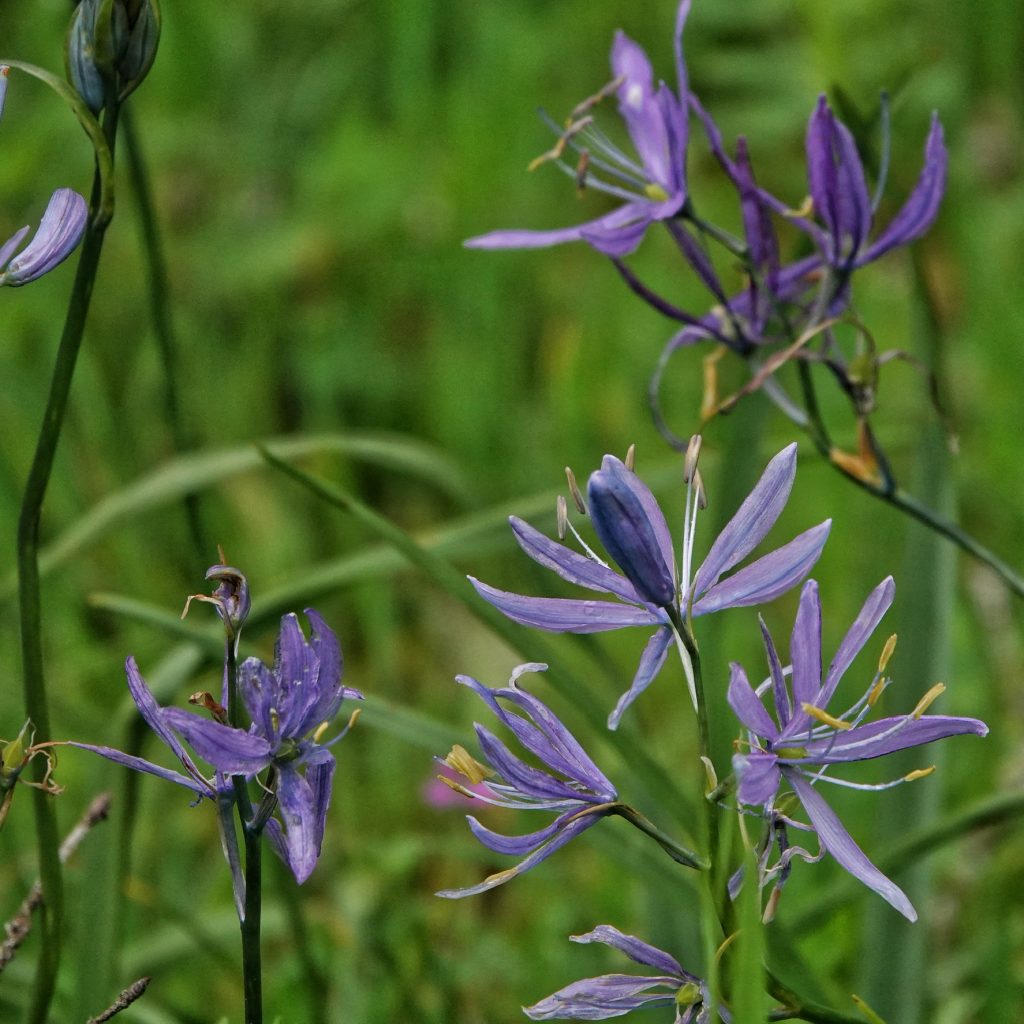
https://oregonflora.org/taxa/index.php?taxon=3549
https://www.pnwflowers.com/flower/camassia-quamash
https://www.wnps.org/native-plant-directory/67-camassia-quamash
https://www.fs.fed.us/wildflowers/Rare_Plants/conservation/success/camas_prairie_restoration.shtml
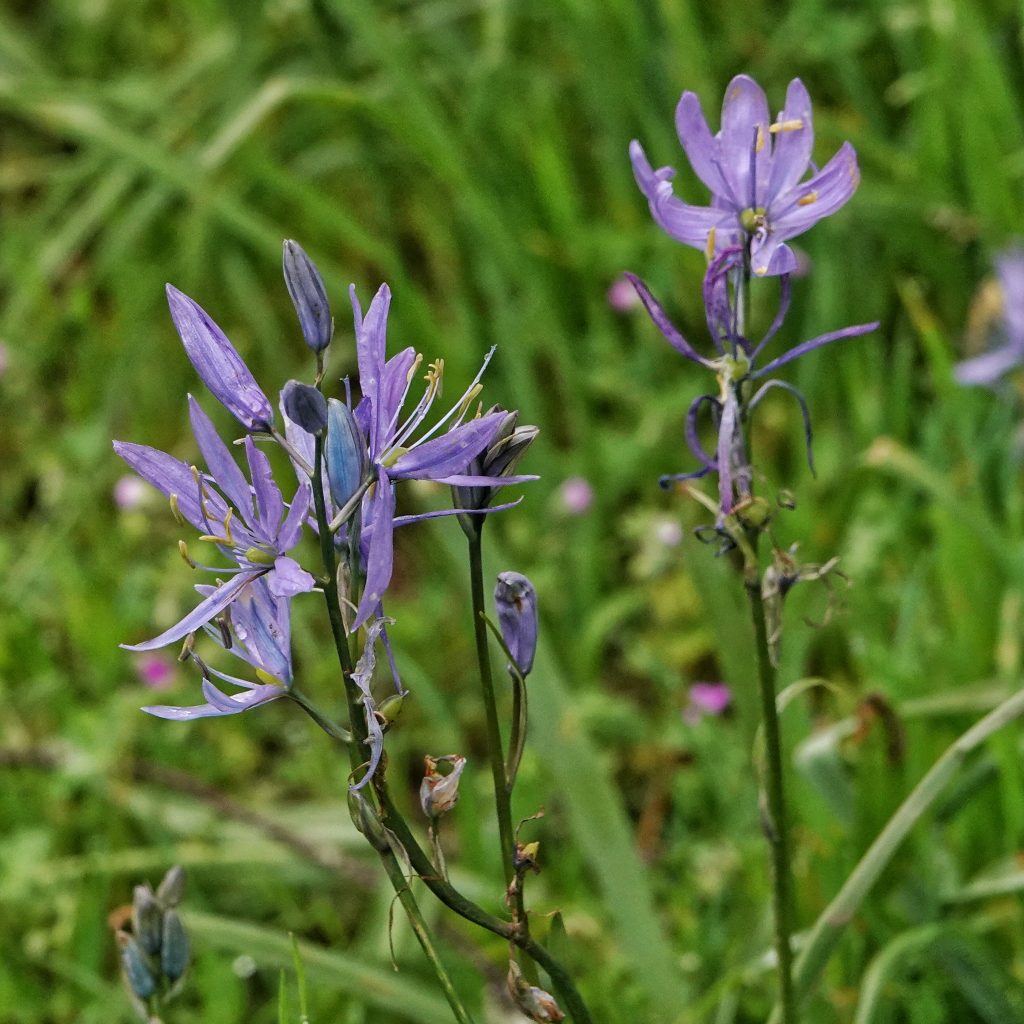
What a great kid you got there. 😊
You are so right! Thanks!
Wonderful post!! I enjoyed this so much! Well done Morgan!! 👍☺️
Hello Morgan, I am so grateful for your presence in the world!! Best Wishes for You:):)
Me too! Thank you!
Nice job! It gives me the warm fuzzies knowing that not just ecological knowledge, but the thirst for it, and the appreciation of it, are still generational.
Will we hear more from you? I’m looking forward to it, if so.
Thank you! We hope so, Kat!